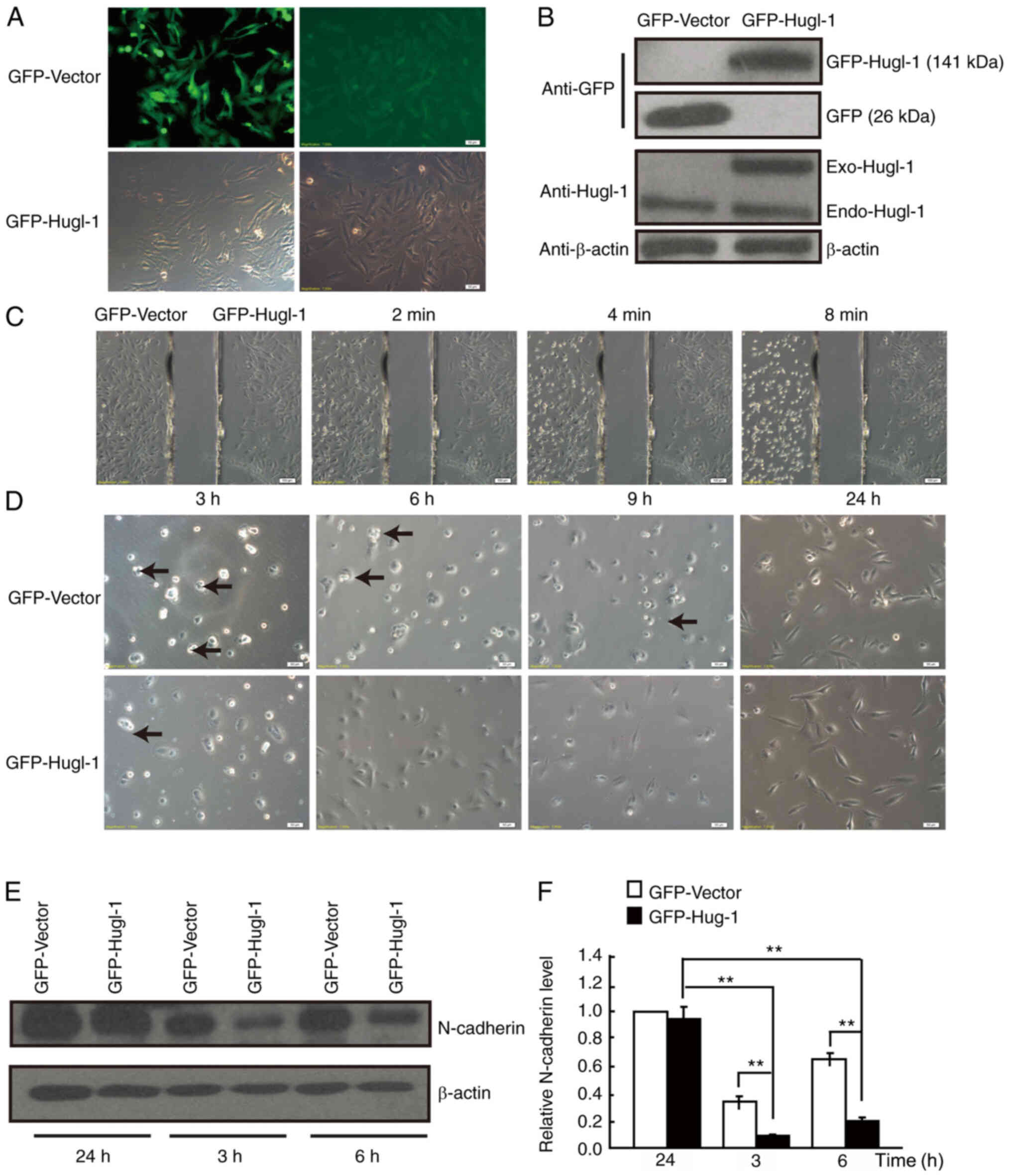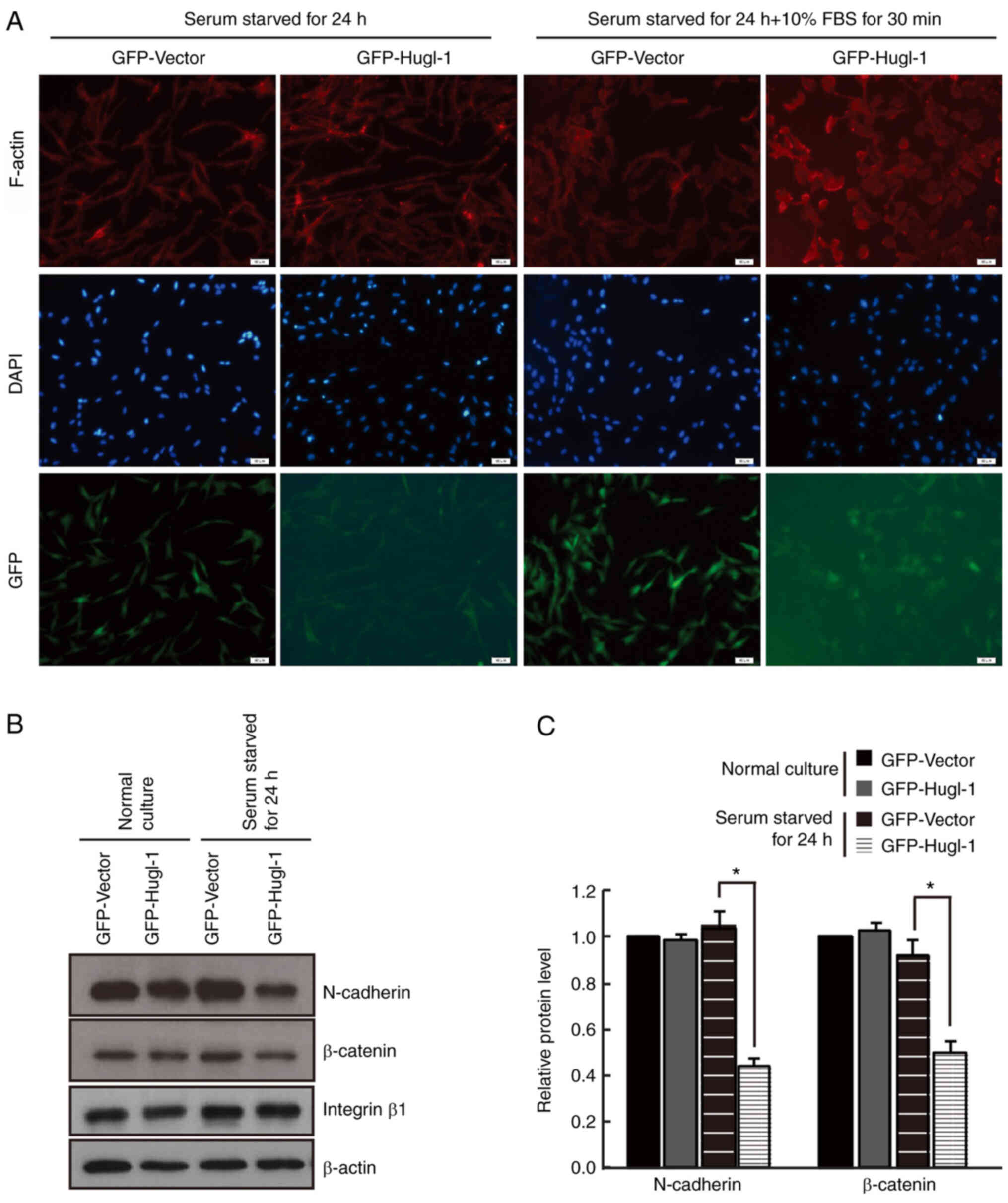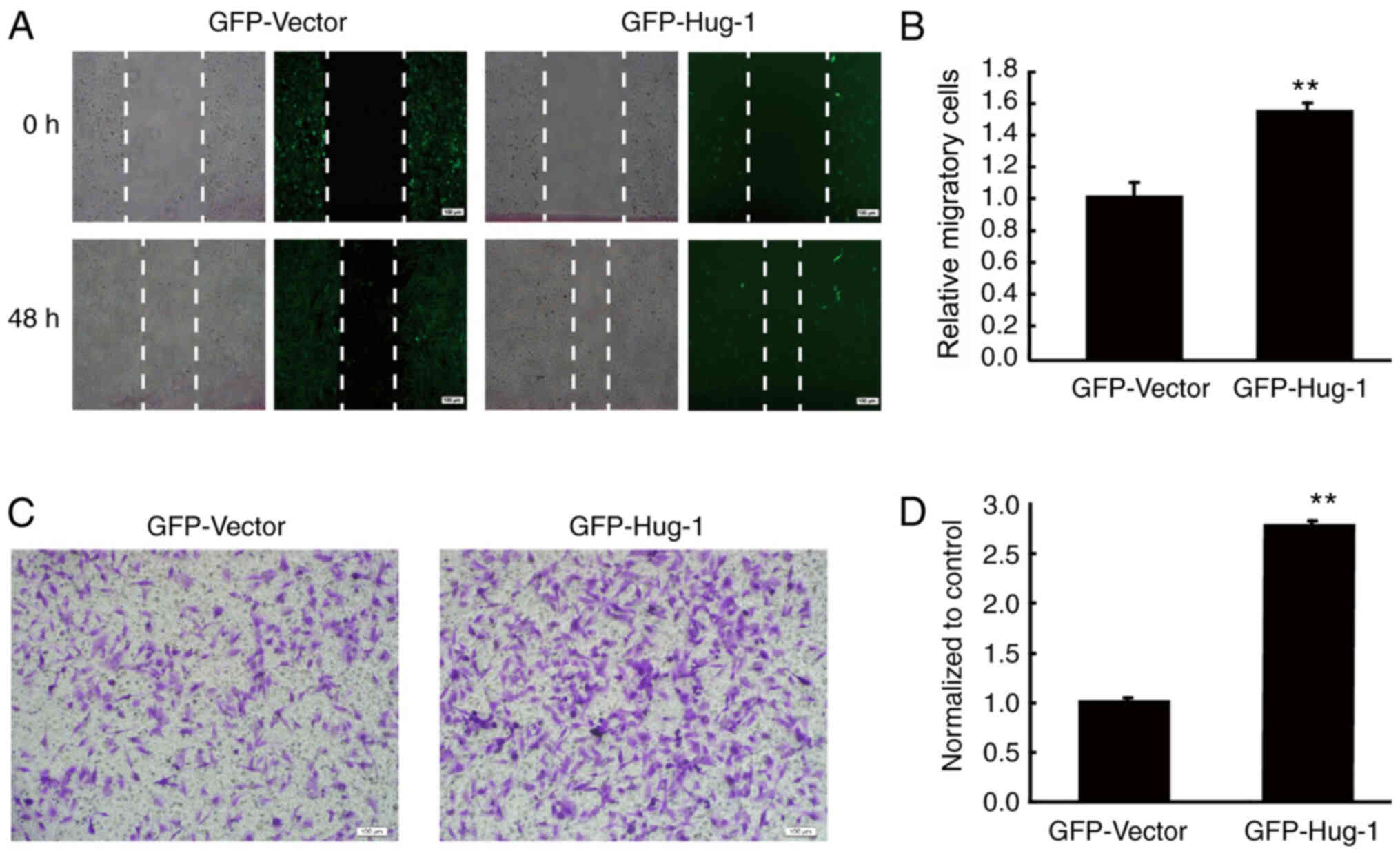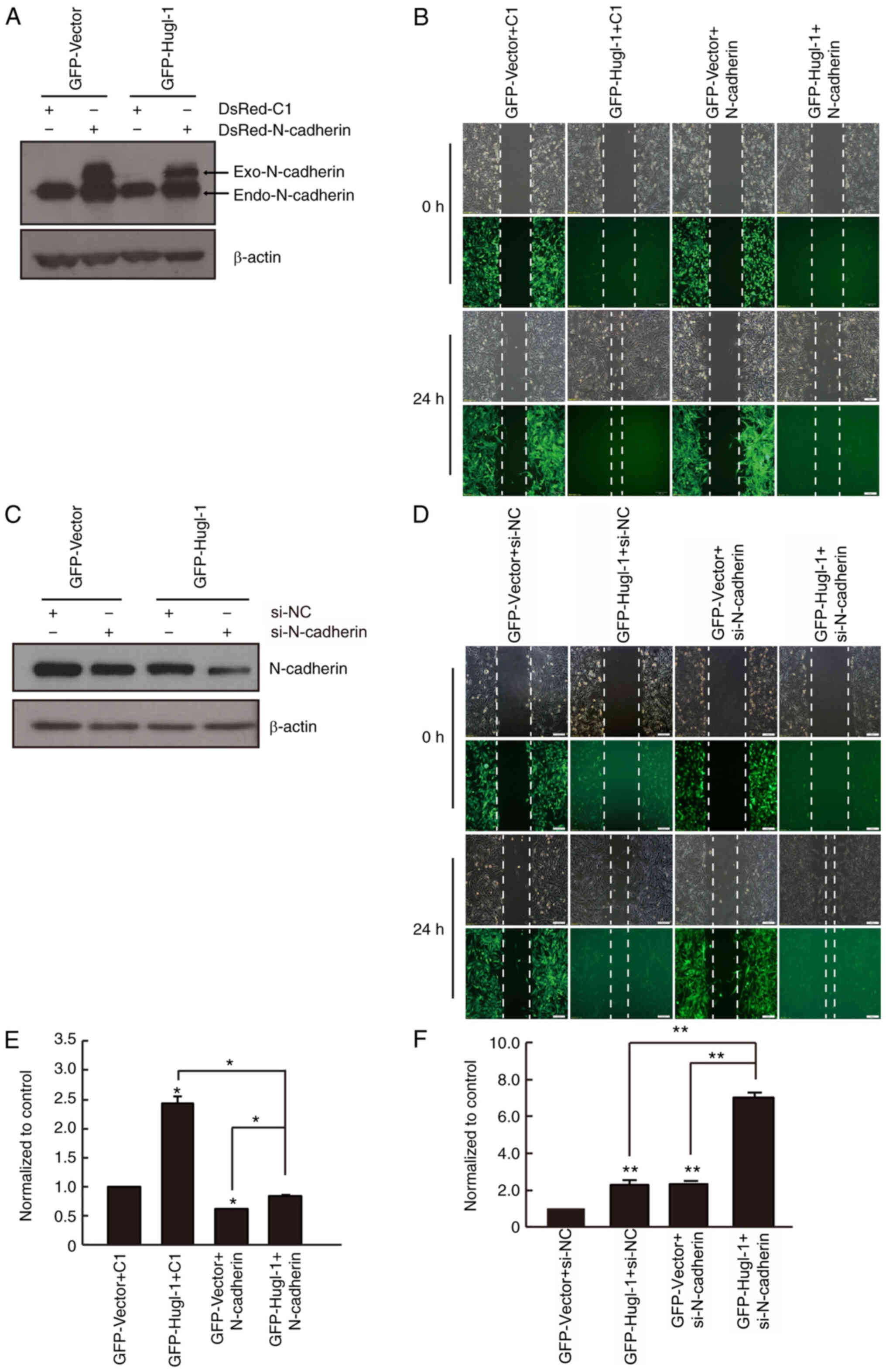|
1
|
Gould J: Breaking down the epidemiology of
brain cancer. Nature. 561:S40–S41. 2018. View Article : Google Scholar : PubMed/NCBI
|
|
2
|
Meyer MA: Malignant gliomas in adults. N
Engl J Med. 359:18502008. View Article : Google Scholar : PubMed/NCBI
|
|
3
|
Osswald M and Morais-de-Sá E: Dealing with
apical-basal polarity and intercellular junctions: A
multidimensional challenge for epithelial cell division. Curr Opin
Cell Biol. 60:75–83. 2019. View Article : Google Scholar : PubMed/NCBI
|
|
4
|
Martin-Belmonte F and Perez-Moreno M:
Epithelial cell polarity, stem cells and cancer. Nat Rev Cancer.
12:23–38. 2011. View
Article : Google Scholar : PubMed/NCBI
|
|
5
|
Hariharan IK and Bilder D: Regulation of
imaginal disc growth by tumor-suppressor genes in
Drosophila. Annu Rev Genet. 40:335–361. 2006. View Article : Google Scholar : PubMed/NCBI
|
|
6
|
Kashyap A, Zimmerman T, Ergül N,
Bosserhoff A, Hartman U, Alla V, Bataille F, Galle PR, Strand S and
Strand D: The human Lgl polarity gene, Hugl-2, induces MET and
suppresses Snail tumorigenesis. Oncogene. 32:1396–1407. 2013.
View Article : Google Scholar : PubMed/NCBI
|
|
7
|
Zimmermann T, Kashyap A, Hartmann U, Otto
G, Galle PR, Strand S and Strand D: Cloning and characterization of
the promoter of Hugl-2, the human homologue of Drosophila
lethal giant larvae (lgl) polarity gene. Biochem Biophys Res
Commun. 366:1067–1073. 2008. View Article : Google Scholar : PubMed/NCBI
|
|
8
|
Grifoni D, Garoia F, Bellosta P, Parisi F,
De Biase D, Collina G, Strand D, Cavicchi S and Pession A: aPKCzeta
cortical loading is associated with Lgl cytoplasmic release and
tumor growth in Drosophila and human epithelia. Oncogene.
26:5960–5965. 2007. View Article : Google Scholar : PubMed/NCBI
|
|
9
|
Ohshiro T, Yagami T, Zhang C and Matsuzaki
F: Role of cortical tumour-suppressor proteins in asymmetric
division of Drosophila neuroblast. Nature. 408:593–596.
2000. View
Article : Google Scholar : PubMed/NCBI
|
|
10
|
Vasioukhin V: Lethal giant puzzle of Lgl.
Dev Neurosci. 28:13–24. 2006. View Article : Google Scholar : PubMed/NCBI
|
|
11
|
Lu X, Feng X, Man X, Yang G, Tang L, Du D,
Zhang F, Yuan H, Huang Q, Zhang Z, et al: Aberrant splicing of
Hugl-1 is associated with hepatocellular carcinoma progression.
Clin Cancer Res. 15:3287–3296. 2009. View Article : Google Scholar : PubMed/NCBI
|
|
12
|
Kuphal S, Wallner S, Schimanski CC,
Bataille F, Hofer P, Strand S, Strand D and Bosserhoff AK:
Expression of Hugl-1 is strongly reduced in malignant melanoma.
Oncogene. 25:103–110. 2006. View Article : Google Scholar : PubMed/NCBI
|
|
13
|
Schimanski CC, Schmitz G, Kashyap A,
Bosserhoff AK, Bataille F, Schäfer SC, Lehr HA, Berger MR, Galle
PR, Strand S and Strand D: Reduced expression of Hugl-1, the human
homologue of Drosophila tumour suppressor gene lgl,
contributes to progression of colorectal cancer. Oncogene.
24:3100–3109. 2005. View Article : Google Scholar : PubMed/NCBI
|
|
14
|
Tsuruga T, Nakagawa S, Watanabe M,
Takizawa S, Matsumoto Y, Nagasaka K, Sone K, Hiraike H, Miyamoto Y,
Hiraike O, et al: Loss of Hugl-1 expression associates with lymph
node metastasis in endometrial cancer. Oncol Res. 16:431–435. 2007.
View Article : Google Scholar : PubMed/NCBI
|
|
15
|
Matsuzaki T, Takekoshi S, Toriumi K,
Kitatani K, Nitou M, Imamura N, Ogura G, Masuda R, Nakamura N and
Iwazaki M: Reduced expression of Hugl 1 contributes to the
progression of lung squamous cell carcinoma. Tokai J Exp Clin Med.
40:169–177. 2015.PubMed/NCBI
|
|
16
|
Biesterfeld S, Kauhausen A, Kost C, Gockel
I, Schimanski CC and Galle PR: Preservation of HUGL-1 expression as
a favourable prognostic factor in pancreatic carcinoma. Anticancer
Res. 32:3153–3159. 2012.PubMed/NCBI
|
|
17
|
Liu X, Lu D, Ma P, Liu H, Cao Y, Sang B,
Zhu X, Shi Q, Hu J, Yu R and Zhou X: Hugl-1 inhibits glioma cell
growth in intracranial model. J Neurooncol. 125:113–121. 2015.
View Article : Google Scholar : PubMed/NCBI
|
|
18
|
Massimi P, Narayan N, Thomas M, Gammoh N,
Strand S, Strand D and Banks L: Regulation of the
hDlg/hScrib/Hugl-1 tumour suppressor complex. Exp Cell Res.
314:3306–3317. 2008. View Article : Google Scholar : PubMed/NCBI
|
|
19
|
Zhong XL and Rescorla FJ: Cell surface
adhesion molecules and adhesion-initiated signaling: Understanding
of anoikis resistance mechanisms and therapeutic opportunities.
Cell Signal. 24:393–401. 2012. View Article : Google Scholar : PubMed/NCBI
|
|
20
|
Fife CM, McCarroll JA and Kavallaris M:
Movers and shakers: Cell cytoskeleton in cancer metastasis. Brit J
Pharmacol. 171:5507–5523. 2014. View Article : Google Scholar
|
|
21
|
Gloushankova NA, Rubtsova SN and Zhitnyak
IY: Cadherin-mediated cell-cell interactions in normal and cancer
cells. Tissue Barriers. 5:e13569002017. View Article : Google Scholar : PubMed/NCBI
|
|
22
|
Pal M, Bhattacharya S, Kalyan G and Hazra
S: Cadherin profiling for therapeutic interventions in Epithelial
Mesenchymal Transition (EMT) and tumorigenesis. Exp Cell Res.
368:137–146. 2018. View Article : Google Scholar : PubMed/NCBI
|
|
23
|
Nair KS, Naidoo R and Chetty R: Expression
of cell adhesion molecules in oesophageal carcinoma and its
prognostic value. J Clin Pathol. 58:343–351. 2005. View Article : Google Scholar : PubMed/NCBI
|
|
24
|
Huang C, Kratzer MC, Wedlich D and Kashef
J: E-cadherin is required for cranial neural crest migration in
Xenopus laevis. Dev Biol. 411:159–171. 2016. View Article : Google Scholar : PubMed/NCBI
|
|
25
|
Bremmer F, Schallenberg S, Jarry H, Küffer
S, Kaulfuss S, Burfeind P, Strauß A, Thelen P, Radzun HJ, Ströbel
P, et al: Role of N-cadherin in proliferation, migration, and
invasion of germ cell tumours. Oncotarget. 6:33426–33437. 2015.
View Article : Google Scholar : PubMed/NCBI
|
|
26
|
Mrozik KM, Blaschuk OW, Cheong CM,
Zannettino ACW and Vandyke K: N-cadherin in cancer metastasis, its
emerging role in haematological malignancies and potential as a
therapeutic target in cancer. BMC Cancer. 18:9392018. View Article : Google Scholar : PubMed/NCBI
|
|
27
|
Camand E, Peglion F, Osmani N, Sanson M
and Etienne-Manneville S: N-cadherin expression level modulates
integrin-mediated polarity and strongly impacts on the speed and
directionality of glial cell migration. J Cell Sci. 125:844–857.
2012. View Article : Google Scholar : PubMed/NCBI
|
|
28
|
Gheldof A and Berx G: Cadherins and
epithelial-to-mesenchymal transition. Prog Mol Biol Transl Sci.
116:317–336. 2013. View Article : Google Scholar : PubMed/NCBI
|
|
29
|
Kourtidis A, Lu R, Pence LJ and
Anastasiadis PZ: A central role for cadherin signaling in cancer.
Exp Cell Res. 358:78–85. 2017. View Article : Google Scholar : PubMed/NCBI
|
|
30
|
Kashima T, Kawaguchi J, Takeshita S,
Kuroda M, Takanashi M, Horiuchi H, Imamura T, Ishikawa Y, Ishida T,
Mori S, et al: Anomalous cadherin expression in osteosarcoma.
Possible relationships to metastasis and morphogenesis. Am J
Pathol. 155:1549–1555. 1999. View Article : Google Scholar : PubMed/NCBI
|
|
31
|
Han ZX, Wang XX, Zhang SN, Wu JX, Qian HY,
Wen YY, Tian H, Pei DS and Zheng JN: Downregulation of PAK5
inhibits glioma cell migration and invasion potentially through the
PAK5-Egr1-MMP2 signaling pathway. Brain Tumor Pathol. 31:234–241.
2014. View Article : Google Scholar : PubMed/NCBI
|
|
32
|
Li F, Jin D, Guan L, Zhang CC, Wu T, Wang
YJ and Gao DS: CEP55 promoted the migration, invasion and
neuroshpere formation of the glioma cell line U251. Neurosci Lett.
705:80–86. 2019. View Article : Google Scholar : PubMed/NCBI
|
|
33
|
Wang T, Liu Y, Xu XH, Deng CY, Wu KY, Zhu
J, Fu XQ, He M and Luo ZG: Lgl1 activation of rab10 promotes axonal
membrane trafficking underlying neuronal polarization. Dev Cell.
21:431–444. 2011. View Article : Google Scholar : PubMed/NCBI
|
|
34
|
Wicki A, Lehembre F, Wick N, Hantusch B,
Kerjaschki D and Christofori G: Tumor invasion in the absence of
epithelial-mesenchymal transition: Podoplanin-mediated remodeling
of the actin cytoskeleton. Cancer Cell. 9:261–272. 2006. View Article : Google Scholar : PubMed/NCBI
|
|
35
|
Li N, Chen G, Liu J, Xia Y, Chen H, Tang
H, Zhang F and Gu N: Effect of surface topography and bioactive
properties on early adhesion and growth behavior of mouse
preosteoblast MC3T3-E1 cells. ACS Appl Mater Interfaces.
6:17134–17143. 2014. View Article : Google Scholar : PubMed/NCBI
|
|
36
|
Lewczuk Ł, Pryczynicz A and
Guzińska-Ustymowicz K: Cell adhesion molecules in endometrial
cancer-A systematic review. Adv Med Sci. 64:423–429. 2019.
View Article : Google Scholar : PubMed/NCBI
|
|
37
|
McKeown SJ, Wallace AS and Anderson RB:
Expression and function of cell adhesion molecules during neural
crest migration. Dev Biol. 373:244–257. 2013. View Article : Google Scholar : PubMed/NCBI
|
|
38
|
Zhan T, Rindtorff N and Boutros M: Wnt
signaling in cancer. Oncogene. 36:1461–1473. 2017. View Article : Google Scholar : PubMed/NCBI
|
|
39
|
Taciak B, Pruszynska I, Kiraga L, Bialasek
M and Krol M: Wnt signaling pathway in development and cancer. J
Physiol Pharmacol. 69:2018.PubMed/NCBI
|
|
40
|
Li ZH, Zhou Y, Ding YX, Guo QL and Zhao L:
Roles of integrin in tumor development and the target inhibitors.
Chin J Nat Med. 17:241–251. 2019.PubMed/NCBI
|
|
41
|
Li JC, Cheng LC and Jiang HY: Cell shape
and intercellular adhesion regulate mitotic spindle orientation.
Mol Biol Cell. 30:2458–2468. 2019. View Article : Google Scholar : PubMed/NCBI
|
|
42
|
Mack NA and Georgiou M: The
interdependence of the Rho GTPases and apicobasal cell polarity.
Small GTPases. 5:102014. View Article : Google Scholar : PubMed/NCBI
|
|
43
|
Bonastre E, Brambilla E and
Sanchez-Cespedes M: Cell adhesion and polarity in squamous cell
carcinoma of the lung. J Pathol. 238:606–616. 2016. View Article : Google Scholar : PubMed/NCBI
|
|
44
|
Waghmare I and Kango-Singh M: Loss of cell
adhesion increases tumorigenic potential of polarity deficient
scribble mutant cells. PLoS One. 11:e01580812016. View Article : Google Scholar : PubMed/NCBI
|
|
45
|
Wan S, Meyer AS, Weiler SME, Rupp C, Tóth
M, Sticht C, Singer S, Thomann S, Roessler S, Schorpp-Kistner M, et
al: Cytoplasmic localization of the cell polarity factor scribble
supports liver tumor formation and tumor cell invasiveness.
Hepatology. 67:1842–1856. 2018. View Article : Google Scholar : PubMed/NCBI
|
|
46
|
Bhattacharya S: Cell polarity: A link to
epithelial-mesenchymal transition and vascular mimicry. Crit Rev
Eukar Gene. 28:101–105. 2018. View Article : Google Scholar
|
|
47
|
Song J, Peng XL, Ji MY, Ai MH, Zhang JX
and Dong WG: Hugl-1 induces apoptosis in esophageal carcinoma cells
both in vitro and in vivo. World J Gastroenterol. 19:4127–4136.
2013. View Article : Google Scholar : PubMed/NCBI
|
|
48
|
Ke LD, Shi YX and Yung WK: VEGF(121),
VEGF(165) overexpression enhances tumorigenicity in U251 MG but not
in NG-1 glioma cells. Cancer Res. 62:1854–1861. 2002.PubMed/NCBI
|
|
49
|
Painter KJ, Armstrong NJ and Sherratt JA:
The impact of adhesion on cellular invasion processes in cancer and
development. J Theor Biol. 264:1057–1067. 2010. View Article : Google Scholar : PubMed/NCBI
|
|
50
|
Cavallaro U and Christofori G: Cell
adhesion and signalling by cadherins and Ig-CAMs in cancer. Nat Rev
Cancer. 4:118–132. 2004. View Article : Google Scholar : PubMed/NCBI
|
|
51
|
Grifoni D, Garoia F, Schimanski CC,
Schmitz G, Laurenti E, Galle PR, Pession A, Cavicchi S and Strand
D: The human protein Hugl-1 substitutes for Drosophila
lethal giant larvae tumour suppressor function in vivo. Oncogene.
23:8688–8694. 2004. View Article : Google Scholar : PubMed/NCBI
|
|
52
|
Yu FX, Zhao B and Guan KL: Hippo pathway
in organ size control, tissue homeostasis, and cancer. Cell.
163:811–828. 2015. View Article : Google Scholar : PubMed/NCBI
|
|
53
|
Asano K, Duntsch CD, Zhou Q, Weimar JD,
Bordelon D, Robertson JH and Pourmotabbed T: Correlation of
N-cadherin expression in high grade gliomas with tissue invasion. J
Neurooncol. 70:3–15. 2004. View Article : Google Scholar : PubMed/NCBI
|
|
54
|
Jossin Y, Lee M, Klezovitch O, Kon E,
Cossard A, Lien WH, Fernandez TE, Cooper JA and Vasioukhin V: Llgl1
connects cell polarity with cell-cell adhesion in embryonic neural
stem cells. Dev Cell. 41:481–495.e5. 2017. View Article : Google Scholar : PubMed/NCBI
|













